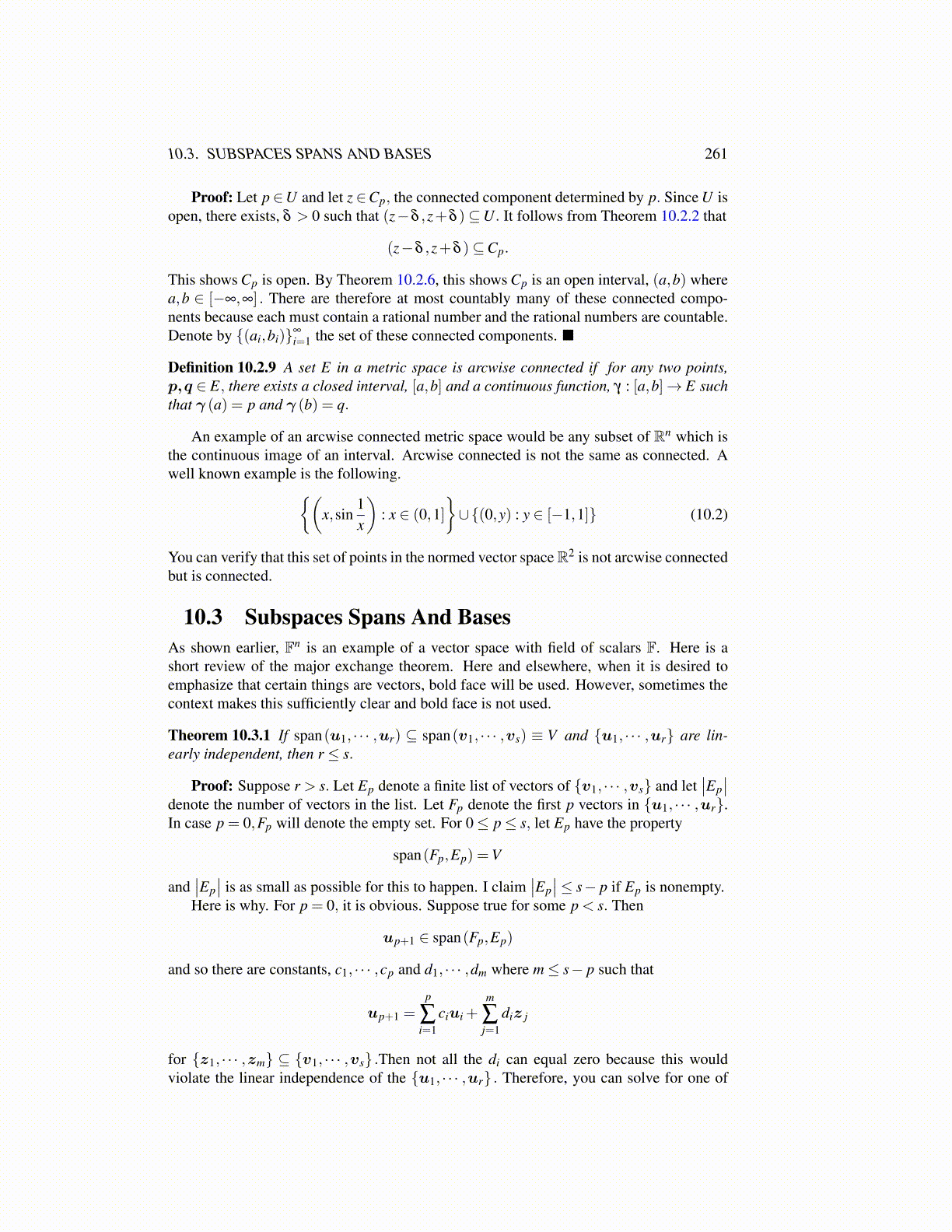
10.3. SUBSPACES SPANS AND BASES 261
Proof: Let p ∈U and let z ∈Cp, the connected component determined by p. Since U isopen, there exists, δ > 0 such that (z−δ ,z+δ )⊆U. It follows from Theorem 10.2.2 that
(z−δ ,z+δ )⊆Cp.
This shows Cp is open. By Theorem 10.2.6, this shows Cp is an open interval, (a,b) wherea,b ∈ [−∞,∞] . There are therefore at most countably many of these connected compo-nents because each must contain a rational number and the rational numbers are countable.Denote by {(ai,bi)}∞
i=1 the set of these connected components. ■
Definition 10.2.9 A set E in a metric space is arcwise connected if for any two points,p,q ∈ E, there exists a closed interval, [a,b] and a continuous function, γ : [a,b]→ E suchthat γ (a) = p and γ (b) = q.
An example of an arcwise connected metric space would be any subset of Rn which isthe continuous image of an interval. Arcwise connected is not the same as connected. Awell known example is the following.{(
x,sin1x
): x ∈ (0,1]
}∪{(0,y) : y ∈ [−1,1]} (10.2)
You can verify that this set of points in the normed vector spaceR2 is not arcwise connectedbut is connected.
10.3 Subspaces Spans And BasesAs shown earlier, Fn is an example of a vector space with field of scalars F. Here is ashort review of the major exchange theorem. Here and elsewhere, when it is desired toemphasize that certain things are vectors, bold face will be used. However, sometimes thecontext makes this sufficiently clear and bold face is not used.
Theorem 10.3.1 If span(u1, · · · ,ur) ⊆ span(v1, · · · ,vs) ≡ V and {u1, · · · ,ur} are lin-early independent, then r ≤ s.
Proof: Suppose r > s. Let Ep denote a finite list of vectors of {v1, · · · ,vs} and let∣∣Ep∣∣
denote the number of vectors in the list. Let Fp denote the first p vectors in {u1, · · · ,ur}.In case p = 0,Fp will denote the empty set. For 0≤ p≤ s, let Ep have the property
span(Fp,Ep) =V
and∣∣Ep∣∣ is as small as possible for this to happen. I claim
∣∣Ep∣∣≤ s− p if Ep is nonempty.
Here is why. For p = 0, it is obvious. Suppose true for some p < s. Then
up+1 ∈ span(Fp,Ep)
and so there are constants, c1, · · · ,cp and d1, · · · ,dm where m≤ s− p such that
up+1 =p
∑i=1
ciui +m
∑j=1
diz j
for {z1, · · · ,zm} ⊆ {v1, · · · ,vs} .Then not all the di can equal zero because this wouldviolate the linear independence of the {u1, · · · ,ur} . Therefore, you can solve for one of